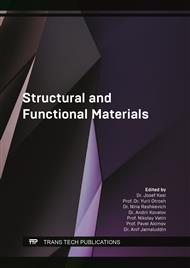p.162
p.175
p.182
p.195
p.202
p.209
p.217
p.225
p.233
Evaluation of Pozzolanic Activity of Mineral Additives for Hydraulic Concrete
Abstract:
High the quality and reliability of hydraulic engineering construction is the basis of civil engineering technology. The use of mineral additives in hydraulic concrete decreases heat dissipation, contribute to a reduced adiabatic rise in the temperature of concrete, improve its performance characteristics and increase durability. Application of such materials will reduce binder consumption without the decrease of concrete properties and mostly even impoving the properties of mortar and concrete. An indirect method of pozzolanic activity evaluation of low-calcium fly ash, volcanic slag, volcanic tuff and waste basalt powder was applied in the study. The investigation shows that volcanic slag is additive with the least volume increase at age of 30 days and it has high pozzolanic properties. The results show that it can be used as base pozzolanic additive for economically and technologically effective hydraulic concrete, superior to non-additive concrete. Use of pozzolanic additives will positively affect the environment due to Portland cement use decrease and the utilization of waste dumps, decrease cost of concrete and a more rational use of natural resources and sustainable development.
Info:
Periodical:
Pages:
202-208
Citation:
Online since:
July 2022
Authors:
Price:
Сopyright:
© 2022 Trans Tech Publications Ltd. All Rights Reserved
Share:
Citation:


